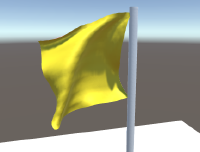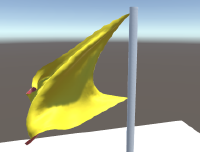Tether Constraints 
Tether constraints are very similar in nature to distance constraints, however they are designed with one very specific goal in mind: to reduce overstretching in long chains of distance constraints.
Because of the iterative nature of Obi's solver, constraints potentially need an infinite amount of iterations to converge. In long chains of constraints, this means that the individual error of each constraint accumulates troughout the whole chain and the final error can be very noticeable, specially when some particles in the chain are attached. When tether constraints are introduced between attached and free particles, they force free particles to stay under a certain distance from their nearest attached particle(s).
These constraints are automatically generated from one or more particle groups by clicking the Generate Tethers button in the cloth blueprint inspector.

Tether scale
Scales the initial length of tethers. Values > 1 will extend the tethers, while values < 1 will shorten them.



From left to right: flag with tether scale of 1, 1.2 and 2. As you can see, longer tethers allow free particles to separate more from the two fixed particles at the corners of the flag that keep it tied to the post. This causes the flag to look stretchy like it would with no tethers at all.
Tether compliance (m/N)
This controls how much constraints will resist stretching. At high values, constraints will offer little resistance to stretching. Low values will increase the constraint stiffness. A value of zero (the default) will try to achieve complete stiffness, whether or not it is achieved depends on the simulation budget (timestep size and amount of tether constraint iterations).